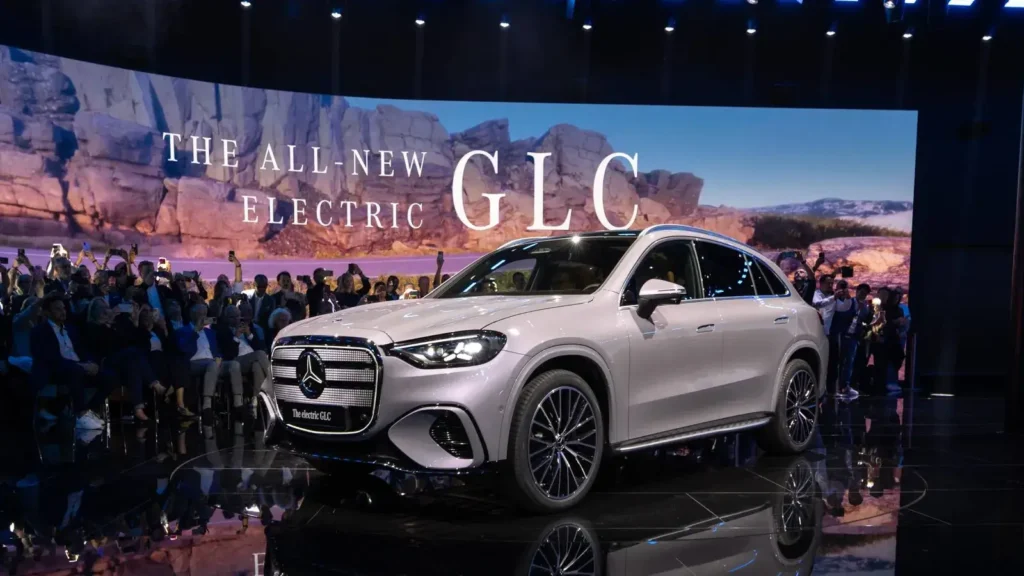When Jaguar rolled its futuristic Type 00 concept onto the manicured lawns of Monterey Car Week 2025, it wasn’t just showing off another design study. It was laying its entire brand future on the line. The British marque, a century old and historically tied to heritage styling, is throwing convention out the window and betting everything on a radical electric flagship that looks more like a sci-fi rendering than a car you’ll find in a showroom.
The Type 00 (and yes, Jaguar insists you pronounce it “zero zero” rather than “double-oh”) made appearances at MotorLux, The Quail, and various private unveilings throughout the week, and it quickly became one of the most controversial talking points of the show. Some onlookers were dazzled. Others were baffled. But everyone agreed on one thing: you couldn’t ignore it.
This is more than just a concept car. It’s the cornerstone of Jaguar’s planned relaunch, and its reception will shape whether the company can successfully pivot into the next generation of luxury EVs.
A Radical Break From Jaguar Tradition
Jaguar has always carried a certain image—elegant grand tourers, understated British refinement, a connection to heritage even when dabbling in modernity. Cars like the E-Type and the XJ carved a timeless niche, and even Jaguar’s more recent ventures—like the F-Type sports car or I-PACE EV—kept one foot in tradition.
The Type 00 tosses that rulebook in the bin. The design language is hard, linear, and saturated, almost architectural. At Monterey, the car appeared in French Ultramarine satin finish, a hue so bold it made neighboring concepts look muted. From certain angles, the vehicle resembled the exaggerated sketches of a teenage gearhead, all sharp edges and exaggerated proportions.
That look is no accident. Jaguar’s design team deliberately wanted to avoid retro cues. This is a total reset, positioning Jaguar not as a brand with a dusty past but as an avant-garde rival to Tesla, Lucid, and even the more daring visions coming out of China.
And it worked—at least in terms of attention. Images of the car sparked viral debates earlier this year, with social media skeptics accusing Jaguar of using AI-generated renders. Seeing it on the ground in California settled the matter: it’s real, and it’s physically imposing. Photos hardly capture its presence.
Why the Type 00 Matters So Much
Most concept cars exist to test ideas, stir hype, and push design boundaries without binding the brand to a production future. The Type 00 isn’t just a styling exercise. Jaguar executives have tied the company’s entire relaunch strategy to it.
Over the past decade, Jaguar has struggled to define itself in a crowded luxury landscape. The I-PACE, once a pioneering electric crossover, failed to sustain momentum. Its sedan lineup dwindled. And SUVs, while profitable, blurred the brand’s identity in a sea of premium competitors.
The Type 00 is Jaguar’s moonshot—a halo EV meant to reestablish relevance and announce that the company is no longer content to play it safe. The messaging at Monterey was clear: this is not evolution, it’s revolution.
But therein lies the risk. By abandoning nearly every visual tie to its past, Jaguar is betting that consumers will embrace the new image rather than mourn what’s been lost.
The Concept Fantasy vs. Production Reality
If there’s a recurring theme at Monterey Car Week, it’s the gap between the wild concepts on pedestals and the cars you’ll eventually find in showrooms. The Type 00 is no exception.
Right now, the car exists as a pure design statement. It doesn’t have to meet crash safety standards. It doesn’t need to account for manufacturing feasibility, repair logistics, or the realities of cost. It doesn’t even need to be drivable beyond limited demonstrations.
But once Jaguar translates this sculpture into a production-ready EV, compromises will come fast:
- Doors: The show car featured dramatic butterfly doors. Jaguar has already confirmed the production model will be a four-door sedan-style vehicle, which means the butterfly wings won’t survive.
- Interior tech: The concept hides or eliminates touchscreens in favor of tactile, driver-focused design. In practice, regulatory and consumer demand for digital interfaces means at least some screens will reappear.
- Trim materials: The brass accents and radical interior finishes showcased in the prototype are unlikely to scale. Expect toned-down luxury materials in the real version.
- Performance targets: Enthusiasts are hoping for 400+ miles of range and a sub-4-second 0–60 mph time to keep pace with rivals. Whether Jaguar’s engineering team can actually deliver those figures remains to be seen.
In short: enjoy the dream car, but be ready for the real one to look and feel very different.
The Monterey Reactions: Hope Meets Apprehension
Conversations among enthusiasts at Monterey often circled back to the same duality: optimism tempered by skepticism.
On one hand, the vision is inspiring. Jaguar is finally stepping boldly into the EV future, rather than chasing incremental updates. The design is distinctive enough to stand apart in a segment increasingly filled with lookalike SUVs.
On the other, the risks are obvious. Luxury EV buyers have plenty of options already, and Jaguar doesn’t have Tesla’s software ecosystem, Porsche’s performance credentials, or Mercedes’ luxury dominance. If the production Type 00 dilutes the concept too heavily, it risks becoming “just another EV sedan” in an already saturated market.
At the same time, Jaguar’s gamble carries symbolic weight. A successful Type 00 would prove that heritage brands can reinvent themselves without being tethered to nostalgia. A failure could accelerate Jaguar’s slide into irrelevance.
The Wider Luxury Context: Everyone Else Is Loud
One reason the Type 00 generated so much conversation is that it represents a different philosophy of luxury compared to its rivals.
Take a walk around Monterey, and you’ll see it:
- Maybach SUVs plastered with logos and chrome, luxury reduced to brand signaling.
- Bentley’s EXP 15 concept, which leaned on heritage design cues but looked more like a Genesis crossover than a bespoke English coachbuilt machine.
- A sea of high-riding performance SUVs, each louder and glitzier than the last.
In that environment, Jaguar’s car—quietly badged, understated, driver-centric—felt refreshing. The leaping cat emblem was etched subtly into side trim. The hood was free of ornamentation. It felt less like a mobile billboard and more like a deliberate rejection of excess.
That’s not to say the Type 00 is restrained—it’s an eye-catching, polarizing sculpture—but it aims for refinement and innovation rather than ostentation.
Jaguar’s Three Pillars: Understatement, Refinement, Innovation
If Jaguar’s team emphasized anything during Monterey Car Week, it was that the Type 00 embodies a new brand philosophy:
- Understatement: Almost no visible badging, no oversized logos, a design that speaks for itself.
- Refinement: Luxurious materials, tactile design, a focus on the driving experience rather than layers of digital distraction.
- Innovation: A body style and aesthetic unlike anything Jaguar—or any other luxury automaker—has produced before.
These pillars may sound like marketing buzzwords, but they’re an attempt to carve out a unique identity in a crowded space. Where Porsche leans on performance, Tesla on technology, and Bentley on heritage, Jaguar is trying to claim a lane of quiet, radical elegance.
What’s Next for the Type 00
The production reveal is expected sometime next year, with deliveries likely following in late 2026. Between now and then, the car will undergo the gauntlet of engineering, regulatory approval, and cost-cutting that separates concepts from reality.
The Monterey showing wasn’t about specifications or technical deep dives—it was about planting a flag. But by the time the public sees the production car, the conversation will shift to:
- Range and charging speed: Can Jaguar compete with Lucid’s long legs and Tesla’s Supercharger network?
- Driving dynamics: Will the car carry forward Jaguar’s reputation for handling finesse in an electric era?
- Price point: Can Jaguar justify six-figure pricing without the brand cachet of Porsche or Ferrari?
- Scalability: Can this be more than a halo car and influence the rest of Jaguar’s lineup?
Jaguar’s leadership insists the production model will remain a “recognizable relative” of the concept. If that’s true, it could be the most exciting car the company has produced in decades. If not, it risks becoming another compromised EV in a sea of lookalikes.
A High-Stakes Gamble for a Storied Brand
The Jaguar Type 00’s Monterey Car Week debut was more than a spectacle. It was a litmus test for Jaguar’s future.
It’s hard not to admire the ambition. At a time when many luxury brands are doubling down on heritage, badges, and flashy SUVs, Jaguar is zigging while others zag. The Type 00 is polarizing, futuristic, and divisive, but it’s also undeniably memorable—something Jaguar hasn’t been able to claim in a long time.
If the production version keeps even half of what makes the concept so striking, Jaguar may carve a new identity that attracts a fresh wave of buyers. If it stumbles, the brand risks fading further into the background of a rapidly evolving EV market.
For now, though, the Type 00 has done exactly what it needed to do: make us stop, stare, and talk about Jaguar again.

